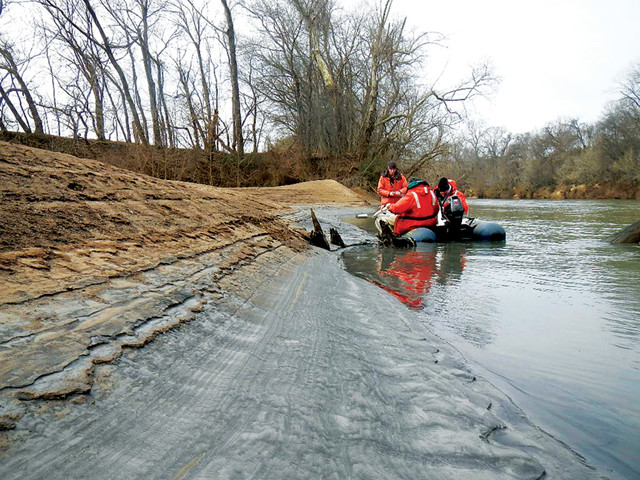
by Sarah Derouin Wednesday, January 10, 2018

U.S. Fish and Wildlife Service and Duke Energy representatives sample coal ash deposited on the bank of the Dan River in North Carolina days after a massive coal ash spill in 2014. Credit: Steve Alexander, USFWS.
Coal burning produces an array of chemicals and particulates that, when released into the atmosphere, contribute to pollution, poor air quality and threats to public health. Measurements of particulate air pollution typically focus on particles called PM2.5, which have diameters of 2.5 micrometers or less. This group includes nano-sized particles, although these bits of minerals, dust and organics often go undetected because of their tiny size. In a new study, researchers sampling a coal ash spill have unearthed a type of nanoparticle not previously known to be produced by burning coal. While the particles might be useful in detecting pollution problems, they may also have consequences for human and environmental health.
“We discovered these [nanoparticles] by accident,” says Michael Hochella, a nanogeoscientist at Virginia Tech and a co-author of the study in Nature Communications. He and his team were looking at a coal ash spill on the Dan River in North Carolina, focusing on iron oxide nanoparticles, which can carry arsenic. In addition to iron oxides, they found unusual-looking titanium oxides. Coal contains many impurities, including the titanium oxide minerals rutile and anatase (both forms of titanium dioxide), but examination of the nanoparticles under an electron microscope revealed distinctive “tiger stripe” patterns characteristic of oxide minerals that have been modified into what are called Magnéli phases through the loss of oxygen atoms from their crystal structure. Magnéli-phase particles are very rare in nature: Previously, they have only been found in interplanetary dust, meteorites, and in a single igneous rock formation in western Greenland. Finding them in the coal ash was a surprise, Hochella says.
The team, curious about how the Magnéli particles were created, tested whether they could be formed by burning coal. Lab experiments in which the researchers combusted coal together with rutile and/or anatase confirmed the hypothesis. Once the team knew these particles existed in the North Carolina coal ash, the researchers started looking to see if they occurred elsewhere around the planet, especially in areas where people burn an abundance of coal, like China. “What’s stunning is that this stuff is all over the planet in nanodust,” Hochella says. He adds that Magnéli particles can travel “many thousands of kilometers in the atmosphere” and potentially as far in rivers too.
The titanium oxide Magnéli particles are an ideal tracer for monitoring air pollution, the team suggested in the study. Something makes a good tracer when it is an “odd material” that occurs only through known processes, Hochella says. The Magnéli particles they found varied depending on the particular coal and the power plant where it was burned, so “the exact Magnéli phase signature is expected to change” from source to source, he notes. Measuring titanium oxide Magnéli particles in the environment could thus be a way for scientists and monitoring agencies to track air pollution from coal burning plants, and to identify if equipment designed to filter or scrub particulates from coal emissions is functioning properly.
“Tracing experiments can be very important,” says Richard Muller, professor emeritus of physics at the University of California, Berkeley, who was not involved with the study. The new work provides another pollution monitoring tool, which is “enormously important,” he says.
Air pollution is “the greatest environmental catastrophe today,” Muller says, although he points out that not all air pollution is the same when it comes to health impacts. “Particles get into the lungs; [they] get into blood,” he says, but “why and how they do harm is not deeply understood.”
Hochella says it’s already known that the titanium oxide Magnéli particles are “potentially toxic to human lungs” based on initial biotoxicity tests on zebrafish embryos, which are commonly used as model organisms for toxicity studies. In the study, the researchers observed significant declines in zebrafish embryo survival after exposure to the nanoparticles. However, he notes, the team is only in the beginning stages of examining toxicity to people; the next steps are to test the effects of Magnéli particles on mice and human lung cells in petri dishes. “I imagine this mineral phase will be studied by materials [scientists] and earth scientists for decades to come, especially if we find out it’s potentially toxic.”
© 2008-2021. All rights reserved. Any copying, redistribution or retransmission of any of the contents of this service without the expressed written permission of the American Geosciences Institute is expressly prohibited. Click here for all copyright requests.